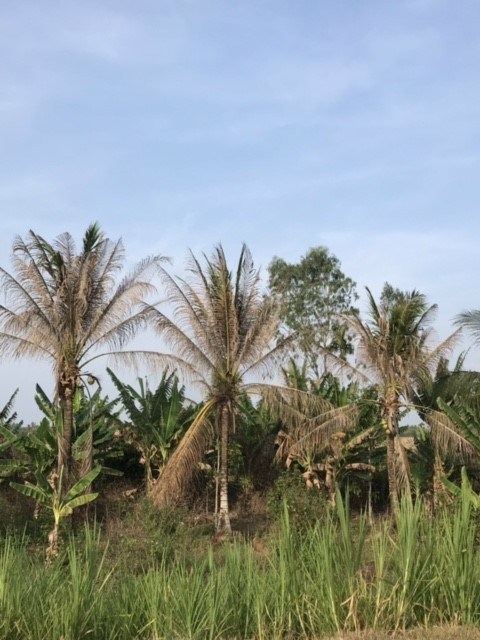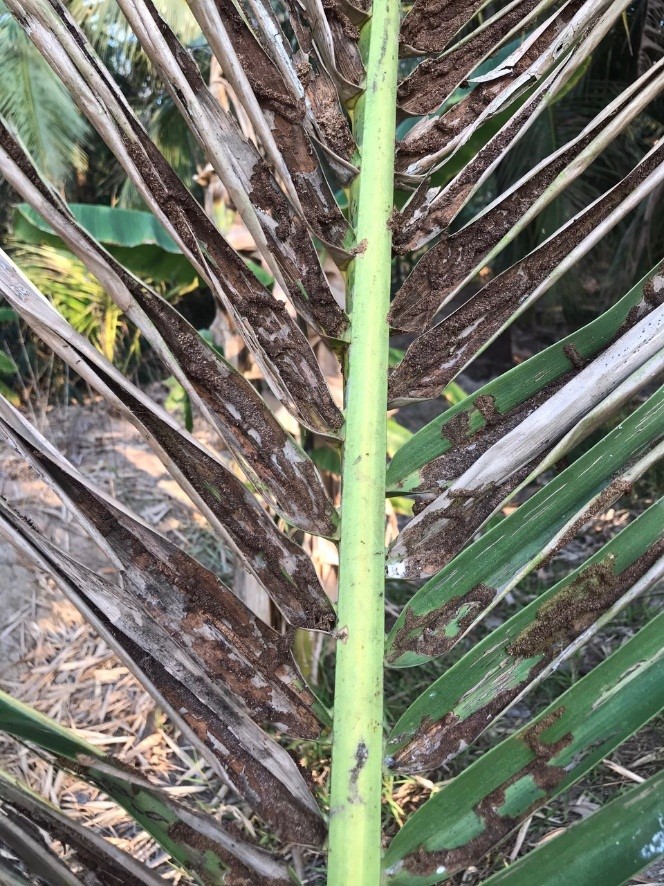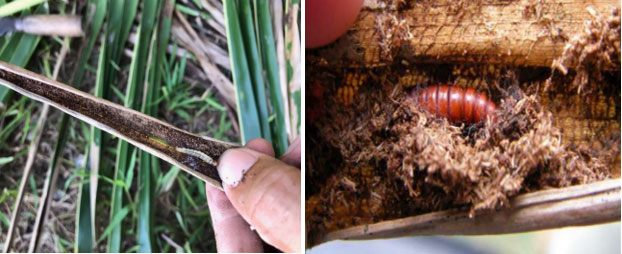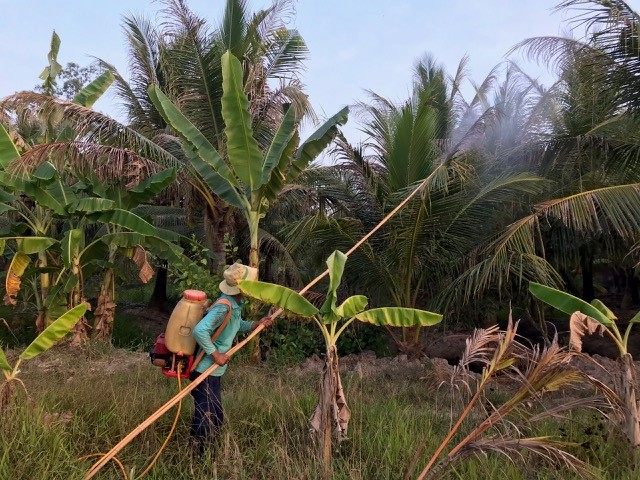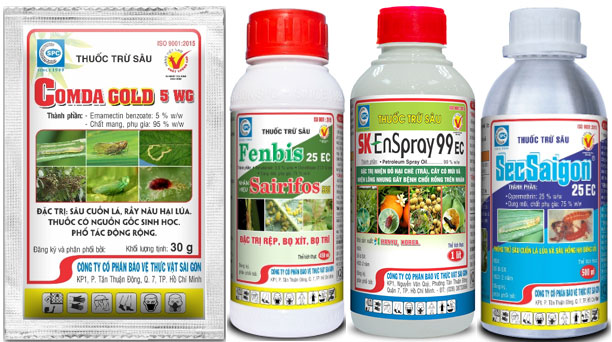|
Coconut Damaging Black-Headed Caterpillar
01/11/2021
MSc. Huynh Kim Ngoc Origin The black-headed catepillar originates from South Asia and damages many coconut growing countries in the Pacific such as India, Sri Lanka, Bangladesh..., Southeast Asia such as Thailand, Indonesia, Myanmar, Cambodia, Vietnam... In Vietnam, black-headed catepillars once appeared in Ben Tre, but with low density, causing negligible harm. However, in 2020, in the province of Ben Tre, Soc Trang, many places with coconut gardens have been severely damaged by black headed caterpillar. Harm:
Leaves and coconut gardens are damaged The blackheaded caterpillar only harms the larval stage, the caterpillar hides inside the leaves, causes damage by scraping the epidermis of the lower leaf surface of the leaves below, excreting feces, releasing silk, then spreading gradually to the upper leaves. Unlike the coconut beetle (Brontispa longissima) which damages the young leaves on the tops, in addition to the leaves, the caterpillars also scrape the leaves. Severely damaged coconuts look shriveled, affecting yield. Identification English name: Black-Headed Caterpillar Scientific name: Opisina arenosella, belongs to the order: Lepidoptera Life cycle
Adult (Moth) Eggmass
Larva Pupa The moth (female) is ash gray, about 10 -15 mm long, with a wingspan of 20 -25 mm, laying hundreds of eggs (50 - 500 eggs) on the underside of the apex of old leaves in about 15-20 days. Newly-aid eggs are light cream color, then turn pink color, incubation period 3-5 days in ( Summer ), can be up to 10 days in( Winter). The newly-hatched larva is about 1.5 mm long, then gradually grows to 15 mm when it is about to pupate. The larvae damage the underside of leaves and the lower leaves about 32 - 48 days. When its enough strength, the larva enters the pupal stage, which is brown in color. 9 to 11 days later, the ash-gray moth exits and begins a new cycle. The life cycle is about 2-3 months . Host trees The trees of the areca family / Palm (Palmae) such as areca, palm, date, rattan... Natural enemies The coconut black-headed caterpillar has many natural enemies, especially natural enemies that parasitize both pupal and larval stages such as Apanteles taragammae, Bracon brevicomis, Elamus nephantids..., the pupal stage is parasitized by Tricliospilus pivora, Stomatoceras sulecatiscute, Brachymeria nephantidis, Xanthopimpla punctate….in Thailand, the parasitic wasps Goniozus nephantidis controls the coconut blackheaded caterpillar well. Prevention: The prevention of coconut black-headed pests is difficult, even by chemical measures due to the tall coconut tree, so it is necessary to detect early and apply integrated measures: 1. Should regularly visit the garden to detect and prevent early, damaged leaves need to be pruned and destroyed. 2. Fertilizer should be balanced, divided into several times of fertilizer in the year. 3. Raising and releasing fire ants, releasing parasitic natural enemies. 4. Use biological lure traps. 5. If the damage is severe, you can spray products like Comda Gold 5WG, Saimida 100SL, Netoxin 95WP, Fenbis 25EC or Sec Saigon 25EC, the above products can be used alone or mixed with SK Enspray 99EC mineral oil, periodically 5. - 7 days can spray 1 time. Pay attention to spray a lot of water, so that the product penetrates deep inside the leaves. Tall tree, can be connected to the spray rod or used to drill, drill into the trunk and pump Comda Gold 5WG (20 cc/tree).
|
To prevent, in addition to plowing and burying weed seeds, collecting weed stalks and stumps left after tilling the land to burn, not letting weeds produce seeds in production fields, etc., the use of chemical products is still a measure. optimal because of its ability to thoroughly kill weeds, reduce labor and take advantage of more time than manual weeding.
Miner has the scientific name Phyllocnistis citrella Staint., family Phyllocnistidae, order Lepidoptera. The miner occurs in many countries in the tropics and subtropics. The main host of the miner is the citrus family - Rutaceae. In addition, the miner also attacks mangosteen and some other plants.
Adult is a small planthopper, with a body 2-3 mm long, the whole body is ash gray, slightly greenish, the wings are opaque with many small brown spots.Eggs are oval, 0.3 mm long, have a pointed end and are attached directly to the leaf surface, leaf axils.
Green bugs specialize in the fruit of citrus groups (oranges, tangerines, lemons, grapefruits, kumquats...), some people call them orange bugs, or orange suckers. Their scientific name is Rhynchocoris poseidon or Rhynchocoris humeralis.
In Vietnam, yellow leaf curl disease is very common on papaya trees, especially the disease is often severe in areas of high and continuous planting, areas with hot and arid climates. The disease has significantly reduced the yield and quality of papaya. Gardens that are infected early when the plants are young may not yield. However, up to now, many gardeners still do not know the cause and how to fix it.
Spider mites are common pests on citrus trees, especially in hot and dry climates that are suitable for spiders to grow and cause severe damage.The group of harmful spiders is usually very small in size, unlike the natural enemy spiders.
This group includes species that are generally very small in size, causing damage by sucking plant sap (on leaves, fruits, branches, stems).
There are many species of mealybugs present on the group of Oranges,Tangerines,Grapefruits and Lemons (Citrus), which can be divided into 2 groups:
+ Group of sticky mealybugs with common varieties such as Lepidosaphes, Aonidiella, Coccus and Saissetia.
+ Group of flower mealybugs with common genera and species such as Pseudococcus, Planococcus and Icerya purchasi.
Dry branches and berries disease often appear to be common damage on coffee gardens during the rainy season. The disease causes death of branchs, dry fruit, severely affects the canopy structure and coffee yield if not paid attention to prevention.
Pink disease commonly causes diseases on rubber plantations in the rainy season, especially on garden from 4-8 years old. This year, rubber has to go through a period of severe drought, weakening the tree, so now in tnshe rainy season it is easy to get infected. Therefore, it is necessary to pay attention to good management to avoid affecting the garden.
In recent years, the area of citrus has been expanded because it is a fruit tree with high economic efficiency. However, in order to sell at a high price, not only in quality but consumers also require the external beauty of the fruit, so pest management on citrus is a matter of great concern to farmers. The hot season is a favorable condition for thrips to develop and cause damage, affecting the commercial value of fruit.
- Headquarters
- SAIGON PLANT PROTECTION JOINT STOCK COMPANY
- RQ 1, Nguyen Van Quy St., Tan Thuan Ward, HCM City
- Tax code: 0300632232
- Tel: (028) 38 733 295 - 38 732 077
- Fax: (028) 38 733 003 - 38 733 391
- Website: www.spchcmc.vn - Email: info@spchcmc.vn
- SAIGON PLANT PROTECTION COMPANY
- SAIGON PLANT PROTECTION JOINT STOCK ENTERPRISE
- Lot C1-C3 Hiep Phuoc Industrial Park, Hiep Phuoc Commune, HCM City
- Tel: (028) 3873 4089 - Fax: (028) 3873 4086
- Affiliated Unit
-
- Quick Links
- Home
- About us
- Career Opportunities


